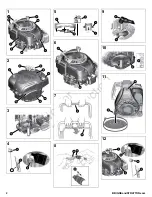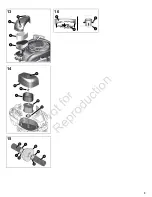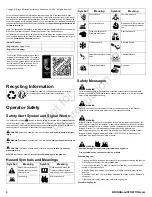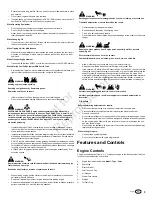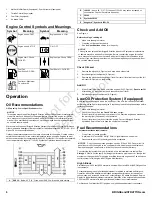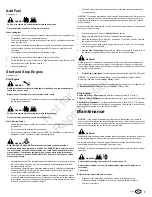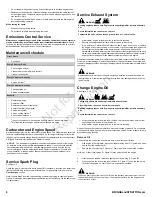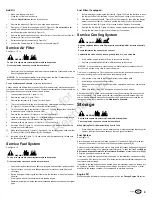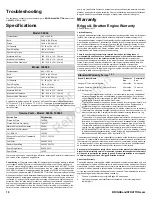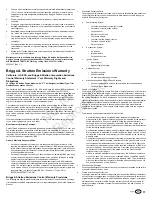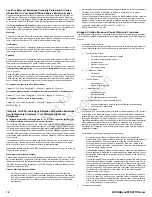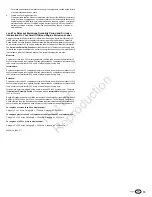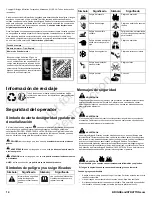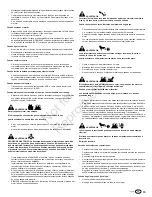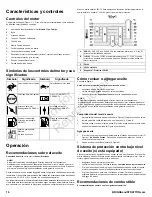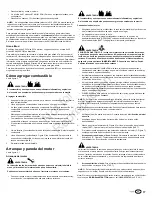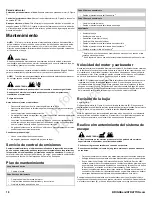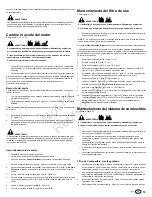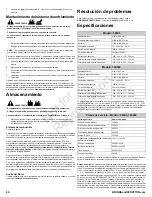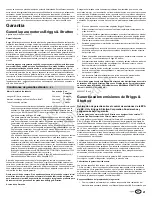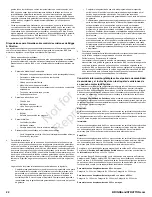
Not for
Reproduction
Add Fuel
See Figure: 5
WARNING
Fuel and its vapors are extremely flammable and explosive.
Fire or explosion can cause severe burns or death.
When adding fuel
•
Turn engine off and let engine cool at least 2 minutes before removing the fuel cap.
•
Fill fuel tank outdoors or in well-ventilated area.
•
Do not overfill fuel tank. To allow for expansion of the fuel, do not fill above the bottom
of the fuel tank neck.
•
Keep fuel away from sparks, open flames, pilot lights, heat, and other ignition sources.
•
Check fuel lines, tank, cap, and fittings frequently for cracks or leaks. Replace if
necessary.
•
If fuel spills, wait until it evaporates before starting engine.
1.
Clean the fuel cap area of dirt and debris. Remove the fuel cap.
2.
Fill the fuel tank (A, Figure 5) with fuel. To allow for expansion of the fuel, do not fill
above the bottom of the fuel tank neck (B).
3.
Reinstall the fuel cap.
Start and Stop Engine
See Figure: 6, 7
Start Engine
WARNING
Rapid retraction of starter cord (kickback) will pull hand and arm toward engine
faster than you can let go.
Broken bones, fractures, bruises or sprains could result.
•
When starting engine, pull the starter cord slowly until resistance is felt and then pull
rapidly to avoid kickback.
WARNING
Fuel and its vapors are extremely flammable and explosive.
Fire or explosion can cause severe burns or death.
When Starting Engine
•
Ensure that spark plug, muffler, fuel cap and air cleaner (if equipped) are in place
and secured.
•
Do not crank engine with spark plug removed.
•
If engine floods, set choke (if equipped) to OPEN / RUN position, move throttle (if
equipped) to FAST position and crank until engine starts.
WARNING
POISONOUS GAS HAZARD. Engine exhaust contains carbon monoxide, a
poisonous gas that could kill you in minutes. You CANNOT see it, smell it, or taste
it. Even if you do not smell exhaust fumes, you could still be exposed to carbon
monoxide gas. If you start to feel sick, dizzy, or weak while using this product,
shut it off and get to fresh air RIGHT AWAY. See a doctor. You may have carbon
monoxide poisoning.
•
Operate this product ONLY outside far away from windows, doors and vents to reduce
the risk of carbon monoxide gas from accumulating and potentially being drawn
towards occupied spaces.
•
Install battery-operated carbon monoxide alarms or plug-in carbon monoxide alarms
with battery back-up according to the manufacturer's instructions. Smoke alarms
cannot detect carbon monoxide gas.
•
DO NOT run this product inside homes, garages, basements, crawlspaces, sheds,
or other partially-enclosed spaces even if using fans or opening doors and windows
for ventilation. Carbon monoxide can quickly build up in these spaces and can linger
for hours, even after this product has shut off.
•
ALWAYS place this product downwind and point the engine exhaust away from
occupied spaces.
NOTICE
This engine was shipped from Briggs & Stratton without oil. Before you start
the engine, make sure you add oil according to the instructions in this manual. If you
start the engine without oil, it will be damaged beyond repair and will not be covered
under warranty.
Note: Equipment may have remote controls. See the equipment manual for location and
operation of remote controls.
1.
Check the engine oil. See the
Check Oil Level section.
2.
Make sure equipment drive controls, if equipped, are disengaged.
3.
Move the throttle control (A, Figure 6), if equipped, to the FAST position. Operate
the engine in the FAST position.
4.
If the product is equipped with an engine stop lever (C, Figure 7), hold the engine
stop lever against the handle.
5.
Rewind Start, if equipped: Firmly hold the starter cord handle (D, Figure 6). Pull
the starter cord handle slowly until resistance is felt, then pull rapidly.
WARNING
Rapid retraction of the starter cord (kickback) will pull your hand and arm toward the
engine faster than you can let go. Broken bones, fractures, bruises or sprains could
result. When starting engine, pull the starter cord slowly until resistance is felt and then
pull rapidly to avoid kickback.
6.
Electric Start, if equipped: Turn the electric start switch to the ON or START position.
NOTICE
To extend the life of the starter, use short starting cycles (five seconds
maximum). Wait one minute between starting cycles.
Note: If the engine does not start after repeated attempts, contact you local dealer or go
to BRIGGSandSTRATTON.com or call 1-800-233-3723 (in USA).
Stop Engine
Engine Stop Lever, if equipped: Release the engine stop lever (E, Figure 7).
Throttle Control, if equipped: Move the throttle control (A, Figure 6) to the STOP position.
Electric Start, if equipped: Turn the electric start switch to the OFF or STOP position.
See the equipment manual for the location and operation of the switch. Remove the key
and keep in a safe place out of the reach of children.
Maintenance
NOTICE
If the engine is tipped during maintenance, the fuel tank, if mounted on
engine, must be empty and the spark plug side must be up. If the fuel tank is not empty
and if the engine is tipped in any other direction, it may be difficult to start due to oil or
gasoline contaminating the air filter and/or the spark plug.
WARNING
When performing maintenance that requires the unit to be tipped, the fuel tank, if mounted
on the engine, must be empty or fuel can leak out and result in a fire or explosion.
We recommend that you see any Briggs & Stratton Authorized Service Dealer for all
maintenance and service of the engine and engine parts.
NOTICE
All the components used to build this engine must remain in place for proper
operation.
WARNING
Unintentional sparking can result in fire or electric shock.
Unintentional start-up can result in entanglement, traumatic amputation, or
laceration.
Fire hazard
Before performing adjustments or repairs:
•
Disconnect the spark plug wire and keep it away from the spark plug.
•
Disconnect battery at negative terminal (only engines with electric start.)
•
Use only correct tools.
7


